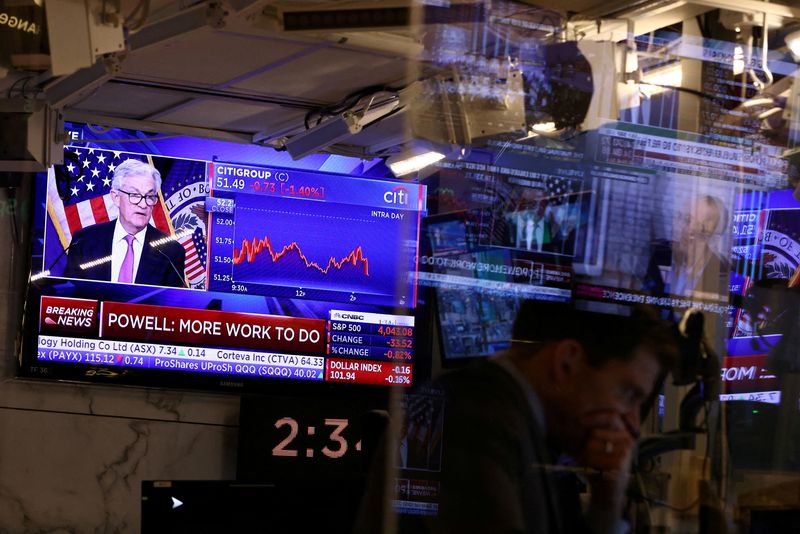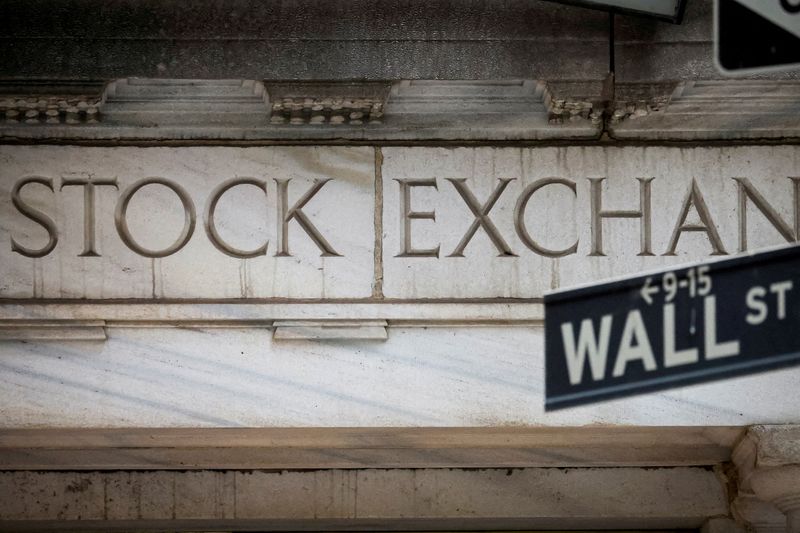By Lewis Krauskopf
NEW YORK (Reuters) – The end of the Federal Reserve’s bruising rate hiking cycle may be in sight, yet investors are finding plenty to worry about when it comes to the U.S. stock market.
In its first meeting since the collapse of two U.S. banks this month and the downfall of ailing European lender Credit Suisse, the Fed on Wednesday raised interest rates by a quarter of a percentage point and indicated it was on the verge of pausing further increases in borrowing costs.
It was a message long awaited by many investors, after the S&P 500’s fall by nearly a fifth last year as the Fed launched its most aggressive monetary policy tightening cycle since the 1980s. Yet some fear the rapid rises in rates are only starting to ripple through the U.S. economy, and remain wary of jumping into stocks amid banking sector turmoil, a downbeat outlook for corporate profits and a looming recession.
“Macroeconomic policy and the outlook for the economy is more complicated than it was two weeks ago,” said Anthony Saglimbene, chief market strategist at Ameriprise Financial, who is holding a lighter than normal equity allocation.
“In that highly uncertain environment, you need to navigate it by being a little bit more cautious and a little bit more defensive,” he said.
Stocks fell on Wednesday, with the benchmark S&P 500 closing down 1.65% after swinging between gains and losses during Fed Chairman Jerome Powell’s press conference following the meeting. The Nasdaq Composite lost 1.6%.
Adding to the market unease were comments from Treasury Secretary Janet Yellen, who told lawmakers on Wednesday that the Federal Deposit Insurance Corporation (FDIC) was not considering “blanket insurance” for deposits arising from recent strife in the sector.
Banking industry stress could trigger a credit crunch with “significant” implications for an economy that Fed officials projected would slow even more this year than previously thought, Powell said.
Analysts at Capital Economics, who believe a recession is likely this year, wrote: “While … the exact impact of the banking turmoil is uncertain, we are now more confident that the Fed’s forecasts for economic growth will prove too optimistic.”
Meanwhile, though the Fed’s latest policy statement no longer said that “ongoing increases” in rates would likely be appropriate, Powell said that inflation remained well above the Fed’s goal and that policymakers were unlikely to cut rates this year, an outlook at odds with that of many investors.
Futures markets are now pricing a Fed funds rate of around 4.25% by year-end, compared with the range of 4.75% to 5% that took effect on Wednesday.
“Sure equities would like a Fed pivot or a point that the Fed would slow down rate hikes, which I think is what they got,” said Charlie Ripley, senior investment strategist at Allianz Investment Management, who has recently increased his allocation to cash. “Powell also said he doesn’t view that rate cuts are plausible at some point this year, so this whole higher-for-longer theme is likely what’s playing out.”
UNCERTAIN OUTLOOK
Stocks have been resilient this year in the face of uncertainty, with the S&P 500 up 2.5% since the end of 2022.
Many investors’ portfolios remain light in equities, a market condition some view as a positive for stocks because of the potential for powerful buying when the market mood shifts. Deutsche Bank’s measure of aggregate equity positioning saw its biggest drop in 15 months last week, the bank’s strategists said in a March 17 note.
A drop in Treasury yields from recent highs has also given a tailwind to stocks, especially to big tech and growth names that are heavily weighted in the S&P 500. Yields move inversely to bond prices.
Still, some investors believe yields may head higher again. Sonal Desai, chief investment officer of Franklin Templeton Fixed Income, said she was skeptical about the recent rally in Treasuries, because inflation remained high.
“I think there’s more volatility to come, without a doubt,” said Desai, who expects the benchmark U.S. 10-year yield will rebound to 4% this year from its current 3.45%.
Corporate profits are another potential trouble spot, with S&P 500 earnings expected to post year-over-year declines in the first and second quarters after falling 3.2% in the fourth quarter of 2022, according to Refinitiv IBES.
That may not even fully reflect the fallout from a potential slowdown brought on by the banking crisis, should lending slow, as many analysts now expect.
“I don’t think the market is going off to the races,” said James Ragan, director of wealth management research at D.A. Davidson. “There is going to be some pressure on earnings going forward.”
(Reporting by Lewis Krauskopf; Additional reporting by Davide Barbuscia; Editing by Ira Iosebashvili and Bradley Perrett)

